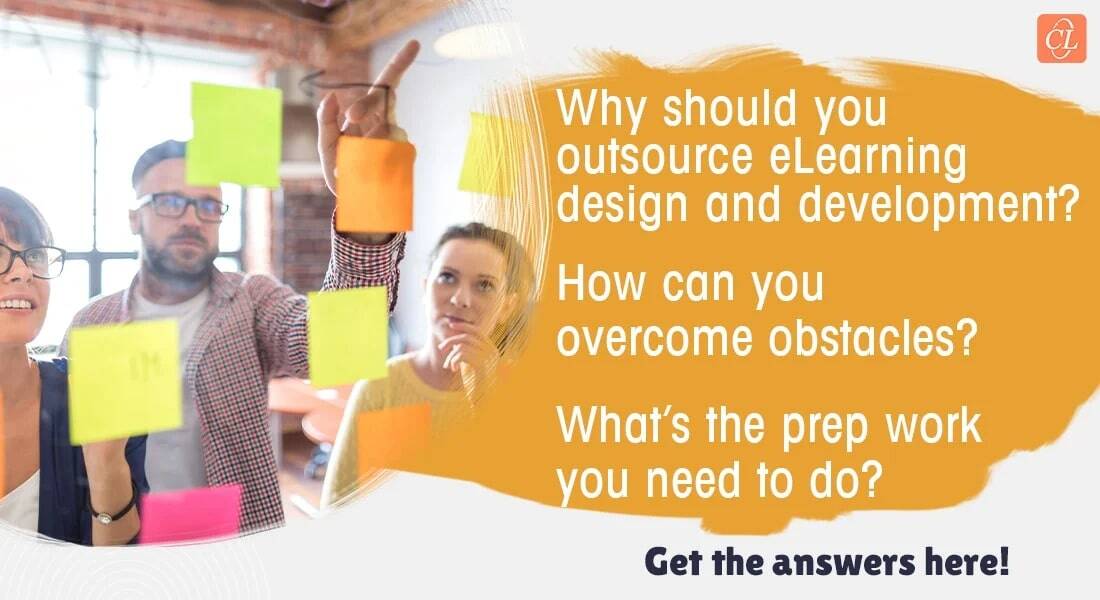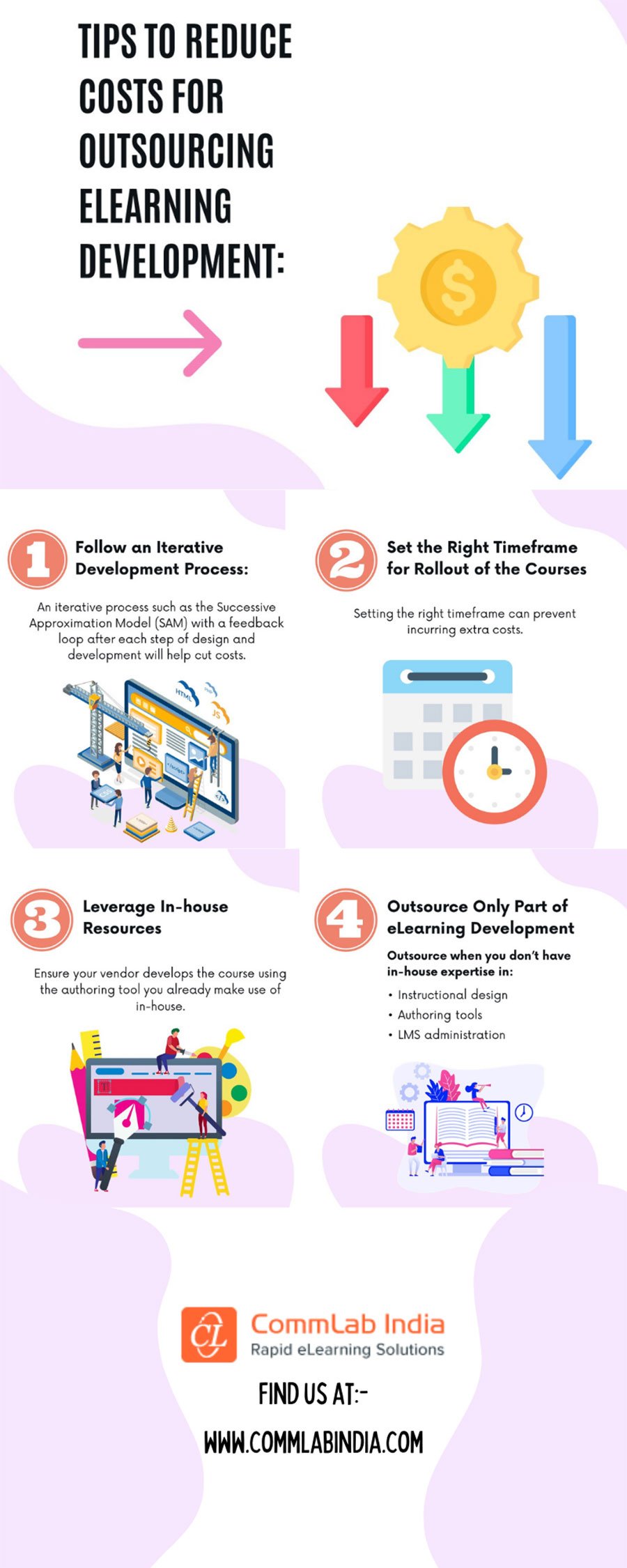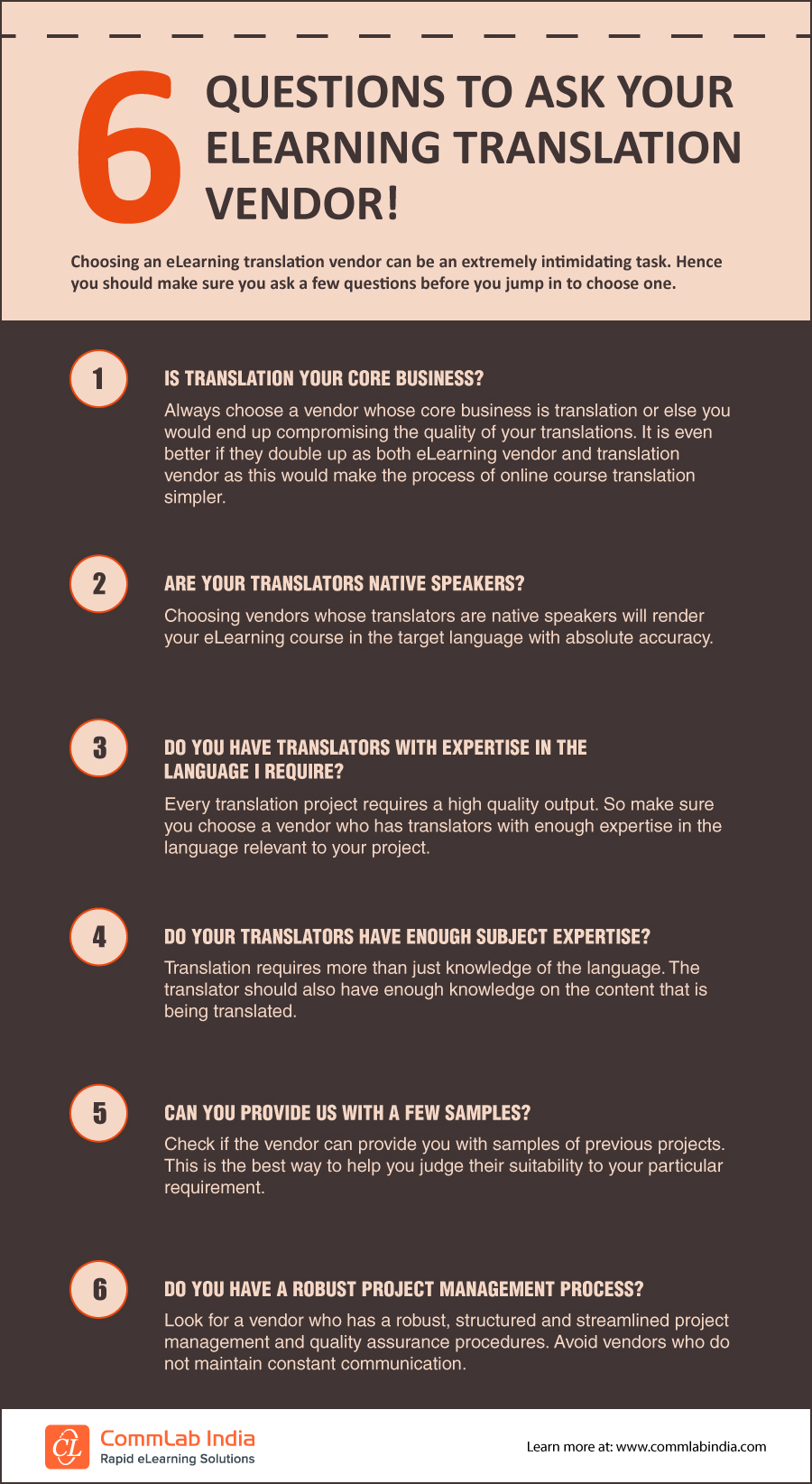Outsourcing eLearning Made Easy — Key Tips and Tricks!

Corporate eLearning design and development is both an art and a science. And to create an effective corporate eLearning course, you’ll need skilled and competent instructional and visual designers, eLearning authoring tool experts, smooth project management processes, and technological support. That’s why organizations that don’t have an in-house L&D team or whose existing team is busy with other tasks prefer to outsource eLearning.
These may include course design, development, and hosting support. Outsourcing eLearning design and development is preferred by organizations that do not have an in-house L&D team or whose workforce is overburdened with other responsibilities.
→ Download Playbook: 2025 Goal Tracker for L&D Managers [Make Winning a Habit!]
Table of Content
- What are the Advantages of eLearning Outsourcing?
- What’s Holding You Back from Outsourcing eLearning Development?
- What Prep Work Should You Do Before Outsourcing eLearning?
- What eLearning Design and Development Tasks Can You Outsource?
- How to Make a Business Case for eLearning Outsourcing?
- How to Choose the Best eLearning Outsourcing Partner?
- How Can You Ensure the Success of eLearning Outsourcing?
What are the Advantages of eLearning Outsourcing?
1. Benefit of Expertise
The eLearning partner brings expertise to the eLearning development process. They will have a team of eLearning experts who can work on a wide range of projects requiring myriad skill sets. Getting the same talent in-house for learning development would mean higher costs. But when you outsource your projects, you get access to experts who are dedicated to meeting your requirements. They will have prior expertise in handling projects similar to yours. They will deliver on a consistent basis and be flexible enough to accommodate your needs.
A competent eLearning company will be up to date on the eLearning authoring tools and will be able to work effectively even with the latest AI tools. They will have a large pool of professionals including instructional designers (IDs) and authoring tool experts to design and develop learner-centric eLearning courses, utilizing iterative project management processes.
The continuous improvement process on the vendor’s side and their experience of handling different clients with varied needs assure you that they will anticipate problems in advance, troubleshoot if required, and even suggest inputs. They would have invested in innovations to come up with contemporary solutions which you can take advantage of. You can capitalize on the experience of your eLearning partner to perfect your eLearning strategy and deliver the best training to your employees.
2. Cost Reduction
Outsourcing definitely reduces costs compared to having an in-house eLearning development team. Outsourcing enables you to reduce fixed costs and take advantage of the eLearning partner’s scalability. You can reduce costs associated with hiring an extensive and expensive in-house team for your needs. By outsourcing, you can reduce the expenses you will incur if hiring your own team.
Outsourcing also gives you the option of creating scalable solutions on-demand. You can increase your budget when required on learning projects or slow down or put projects on hold without additional overheads. You can also reduce expenses associated with acquiring and upgrading technology.
Even if you have an in-house team for eLearning projects, they may have limited capabilities. They can probably work only on the design stage of the eLearning project. Then the development part can be outsourced. You can reduce costs by outsourcing even stages of the projects according to your requirements.
Looking to save on eLearning outsourcing? Check out these practical tips to cut costs without compromising quality in our infographic below!
3. Quick Turnaround
Your outsourcing partner can produce high-quality digital learning solutions quickly compared to an average in-house team. The eLearning company will have a clear schedule of deliverables and ensure your eLearning projects are completed on time. Since your outsourcing partner’s core business is eLearning, their processes and systems are geared to deliver projects on time. They are qualified to meet tight deadlines and ensure faster turnaround.
4. Organizational Focus
Any high-performing business would like to focus on its core competencies and develop them. They will want to invest time and energy in planning for the future, on changes in the organization, acquisition of skills, and the evaluation of training needs. The focus will be on mapping the success of corporate training programs and how well they align with the business needs. Outsourcing eLearning can help maintain your organizational focus and usage of resources. An outsourcing partnership can work beautifully if your people, who know the business, focus on the learning strategy and their outcomes, while the eLearning partner can bring out content that is effective and engaging.
5. Ahead of the Curve
Outsourcing allows you to take advantage of the best practices in eLearning and the latest technologies and trends. The best eLearning companies focus on innovation which ensures there is no stagnation in the corporate learning solutions used by your organization.
The eLearning outsourcing partner gives you access to fresh perspectives, a better understanding of the functionality and capabilities of new technologies. Outsourcing provides you the advantage of staying on top of the latest methods in eLearning and consequently, seeing them applied in your corporate training programs.
6. Option to Scale up or Down
eLearning outsourcing gives you the option of scaling up or down the team size depending on your requirements. You can make use of the services of a team of either 5 or 50 members without having to go through the headache of hiring, training, or retaining them. The eLearning company takes care of these issues. This is significant especially for smaller companies who cannot invest resources of time or money on these matters. When eLearning is outsourced, projects can be started speedily, teams can be ramped up or scaled down depending on the needs of the project.

The 2025 L&D Managers’ Playbook
Make Winning a Habit!
- Take stock of your current state
- Set goals for your personal growth
- Define your professional upskilling targets
- Use the tracker, wheel of life, and other tools
- Stay on the path of success
What’s Holding You Back from Outsourcing eLearning Development?
There may be problems or issues with project management, communication, confidentiality, deliverables, or quality. Here’s how you can work around them.
|
Constraint |
Solution |
|
Project Management |
|
|
Communication |
|
|
Confidentiality |
|
|
Timely Deliverables |
|
|
Quality |
|
And that was about what could be the potential constraints of outsourcing eLearning, and their solutions. Now, let’s go into the groundwork you need to do (before actually outsourcing) that’ll help the project to be successful.
What Prep Work Should You Do Before Outsourcing eLearning?
1. Define Specific, Measurable Learning Objectives
Specific and measurable performance-based learning objectives determine the scope of the course content, the instructional strategy, the course duration, the level of interactivities, and so, ultimately, the costs. Making your intended objectives clear will help your eLearning vendor create online learning courses efficiently. The learning objectives should include performance, condition, and criterion.
2. Review Available Content & Fill Any Gaps
Thoroughly review all available content on the topic – classroom PPTs, whitepapers, PDFs, manuals, and guides. Remove unnecessary and irrelevant information that is not aligned with the set learning objectives. Check for content gaps and take the Subject Matter Expert’s (SME) help in filling those gaps. Update any content that has become obsolete. And then, your content is ready to be sent to your eLearning outsourcing partner.
3. Bring Your Subject Matter Experts On-board (SMEs)
There cannot be a successful eLearning program without the subject matter experts’ (SME) inputs and contribution. They are experts in their domains, usually very skeptical about digital learning. So, investing some time to convince them about the need for eLearning is critical. They are also very busy individuals who find it difficult to take time out for training. You need to respect their time and contribution. And so, plan for curriculums and schedule SME reviews according to their convenience.
What eLearning Design and Development Tasks Can You Outsource?
Tasks That Can Be Outsourced in eLearning
Think of…
1. Rapid eLearning design and development
2. Only eLearning development
3. Decisions on training formats and strategies
4. Instructional design
5. Multimedia components
6. eLearning translations
7. Digital assets for performance support
If you were under the impression that eLearning outsourcing would mean delegating the entire eLearning design and development of your eLearning courses to an eLearning partner, think again. Because you can choose to outsource only a part of it. Especially if you are facing budgetary constraints or have an in-house team who can perform some of the tasks.
Here are 7 different tasks you can outsource in eLearning design and development.
1. Rapid eLearning Design and Development
If you have the content in different formats and different states of readiness (PowerPoint presentations, ILT material, Word documents, videos), eLearning courses will need to be designed and developed from scratch.
That requires expertise in instructional design and authoring tools. If you don’t have an in-house ID team and authoring tool experts, outsourcing the entire eLearning design and development will make sense.
Rapid eLearning is a speedier, equally effective version of custom eLearning – but with a much shorter development time and reduced costs. Rapid eLearning also saves on SMEs’ time by minimizing their touchpoints in the eLearning design and development.
Rapid eLearning takes 30% less time than traditional eLearning for development. And how is that possible? By repurposing available content, creating templates, and standardizing the process. And by eliminating all the frills that are so much a part of traditional eLearning courses. Faster training yields faster results!
2. Only eLearning Development
If you have the content in the form of well-designed storyboards that are ready for production, but lack the resources to develop them into eLearning courses using rapid eLearning authoring tools, consider outsourcing only the course development part to the eLearning vendor. This has the added benefit of requiring minimal SME time and course development resources.
3. Decisions on Training Formats and Strategies
Competent eLearning companies will offer consultation services, and because their core business is eLearning, their inputs will be very useful for you.
You could consult with them on the appropriate formats (eLearning? Microlearning? Blended learning? Standalone course or a curriculum of courses?) and strategies for your online training.
4. Instructional Design
If your in-house team lacks instructional design expertise (learning design and understanding of adult learning principles), you could choose to outsource only the instructional design part of the project. The vendor (with his team of expert instructional designers) will then help you define effective performance-based objectives, decide on the best instructional design strategy, and create assessments that are perfectly aligned with the learning objectives, and more.
5. Multimedia Components
In case your in-house team is finding it challenging to develop, customize, or program complex animations, interactivities, graphics, or videos, you could choose to outsource only the development of those media to a vendor.
Outsourcing will help you save on the costs of hiring people or purchasing tools for these jobs.
6. eLearning Translations
Outsourcing eLearning translations ensures your courses are translated by a network of competent professional native translators as it is very rare to find good quality translators (native speakers of the language) who also have domain knowledge among your in-house staff.
7. Digital Assets for Performance Support
If you have a good in-house team of instructional designers and authoring tool experts, you could use the eLearning partner to generate engaging and compelling performance support assets.
How to Make a Business Case for eLearning Outsourcing?
Make a compelling business case for outsourcing eLearning by including these points in your presentation.
Build a winning eLearning business case with this guide.
Scalability without the Hassles
If you have a need to scale up training (for more learners or on different topics), you don’t have to worry about whether you have enough resources to do it, or if you can realistically meet the deadlines to launch the training – that is, if you outsource eLearning.
Outsourcing will help you ramp-up the design and development of eLearning on-demand, when you need it, according to your requirements.
An experienced eLearning provider would also have an agile project management approach in place to ensure the entire process is streamlined. The Successive Approximations Model (SAM) for eLearning development is agile, iterative, and flexible, and gives you the freedom to provide feedback to the vendor at any time during the process.
Increased Productivity
Outsourcing will give you access to eLearning experts who double up as ‘training consultants’ and help you understand the latest ‘trends’ – how they fit in with your training requirements and the optimal way to use them, rather than including them in your training kit just because everyone else seems to be doing it.
The eLearning company’s highly skilled and experienced instructional designers and tool experts will ensure the courses are more engaging, facilitating learning and improving results. Courses that provide more engagement and interaction mean higher completion rates and better learning, leading to increased productivity and enhanced training ROI.
Improved Quality at a Lower Cost
Outsourcing helps address the training needs of a constantly changing business environment while also keeping costs down. eLearning outsourcing may have higher upfront costs, but the reusability of digital assets makes it a viable and profitable proposition over time.
So, you’ve convinced your stakeholders to opt for outsourcing eLearning. The next step?
Choosing the right eLearning partner!

The 2025 L&D Managers’ Playbook
Make Winning a Habit!
- Take stock of your current state
- Set goals for your personal growth
- Define your professional upskilling targets
- Use the tracker, wheel of life, and other tools
- Stay on the path of success
How to Choose the Best eLearning Outsourcing Partner?
It’s highly critical for the success of your eLearning outsourcing to choose the right vendor to take care of all your requirements. But, with so many eLearning design and development companies in the market, how do you do it?
Here’s a 5-point checklist to select the best eLearning company.
1. Experience, Expertise, and Reliability
Ensure the eLearning company can collaborate well with you, and has expertise in instructional design and custom eLearning development, and the ability to use technology. Check their website:
- If eLearning development is their core business. If it isn’t, this may not be the right fit.
- How long they have been in the eLearning business
- Their experience with eLearning in your domain
- Their thought leadership and customer education programs
- Their social media – posts, promotions, views, and comments
2. Size & Scalability
It is essential to assess the size and scalability of the eLearning vendor.
- Check if the vendor can provide a dedicated team for your projects.
- Ensure that your vendor can ramp up to meet your growing requirements in the future.
- Check for their eLearning translation experience also.
3. Cost to Quality Ratio
While selecting the eLearning partner, consider the ‘cost to quality’ ratio – the cost of your eLearning and the ROI. If you are clear about what you want from the project, comparing vendors in terms of cost (rate per learning hour of eLearning) and what they will deliver for it becomes a simple matter. This will help you narrow down your choice.
4. Samples of Similar Projects
Sample courses will give you a fair idea of their work and their capabilities in using eLearning authoring tools. Carefully assess their instructional design and project management skills, and if they match your requirements and objectives. Conduct a case study of their prior work, speak with other clients if available, and request a demo. Their previous work should give you an idea of the vendor’s capabilities.
5. Client Testimonials
The eLearning partner may show you his best samples. So, a better way to assess them will be references from their clients. Check:
- If they had dedicated teams for projects
- If the team had problems understanding their eLearning requirements
- How they handled feedback and iterations
- Their ability to work across time zones and communicate effectively with stakeholders
How Can You Ensure the Success of eLearning Outsourcing?
Working with a preferred eLearning outsourcing provider has several advantages, one of which is that the vendor knows your organization, your products, processes, and standards. This saves a great deal of time while also improving quality. But there are a few ways you can ensure your outsourcing is a success.
Make Time for Closing Meetings
Closure meetings are a type of audit at the end of the project on what went well and what did not during the project. Understanding what went wrong allows you to focus on the pain points. You can learn from these closure meetings to make your future initiatives smoother, building on the positives and rectifying the flaws.
Opt for a Master Service Agreement (MSA)
An MSA makes future project negotiations easier and faster for you and your eLearning partner, as well as securing better pricing.
Looking for more tips? Watch this video!
Taking the Right Course of Action!
L&D departments are increasingly being tasked with developing effective training courses on tight budgets. Outsourcing eLearning design and development may help reduce total training development costs while also improving the quality of training, ultimately resulting in improved employee performance. It can be a one-stop solution to the challenges that firms have with developing eLearning in-house.
If outsourcing eLearning solutions is part of your strategy, staying organized and focused is key. Download the 2025 L&D Managers’ Playbook—your ultimate tool to define priorities, set measurable goals, and keep your learning initiatives on track. Take the first step toward strategic success today!








![Key Terms Used in E-learning [Infographic]](https://blog.commlabindia.com/hubfs/Imported_Blog_Media/key-elearning-terms-infographic-2.jpg)
![5 Tips for Engaging Employees in Sustainability Training [Infographic]](https://blog.commlabindia.com/hubfs/sustainability-training-engaging-employees.jpg)
